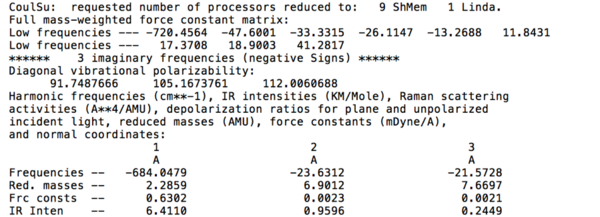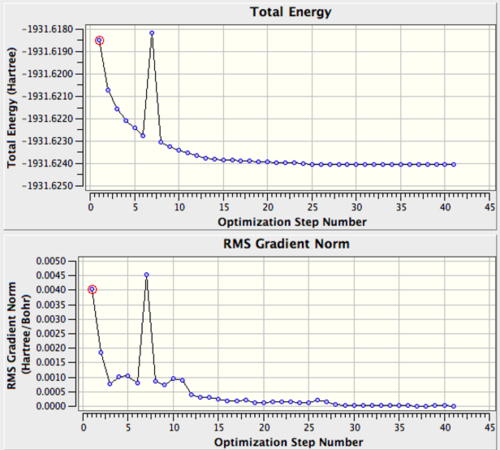Mod:Hunt Research Group:troublesome smd
General problems
- SMD calculations will often have problems with our default criteria "opt scf=conver=9 int=ultrafine"
- you can fail to converge or you can have negative frequencies on performing the frequency analysis
- there are a range of things you can do
- increase the convergence on the SCF "scf=conver=11"
- optimise in cartesian coordinates "opt=(cartesian,maxcycles=50)" cartesian coordinates converge slowly so we need to increase the number of cycles undertaken
- run a frequency analysis and use the frequencies as input "opt=readfc"
- if the distances are not converging "opt=verytight" but be warned this can take a long time, do this only if the forces are converged with the looser criteria!
- useful command line "opt=(cartesian,readfc,maxcycles=50) scf=conver=11"
.
SMD calculations with large imaginary frequencies
During your SMD calculations, you may run into a situation where the Gaussian optimisation has terminated normally but still contains large imaginary frequencies. For example, take a look at the two files below:
Looking at the frequency file:

In general, the optimisation is terminated if one of the two criteria is met: - When the force and the displacement have converged - When the maximum force and RMS force are two orders of magnitude smaller than the threshold shown, regardless of displacement
First check your optimisation log file to see if the energy has been converging. The following is taken directly from the example log file above:

Check in your log file whether the force and the displacement have converged. The following is taken directly from the example log file above.

In this situation, it is likely that your optimisation has run into an area of potential energy surface which is quite flat and hence the optimisation will terminate since the force constant is below the threshold. However, the displacement is far from converging. It is possible to tighten the cutoffs on forces and step size that are used to determine convergence. Copy and paste the optimised structure with large imaginary frequency to new gaussian window and change the optimisation keyword from opt to opt=verytight.
Rerun your optimisation calculation with this keyword. In the four example files below, I have rerun the troublesome smd optimisation I have included earlier in this document.
File:Verytight troublesome smd freq.log
File:Verytight troublesome smd freq.txt
File:Verytight troublesome smd opt.log
File:Verytight troublesome smd opt.txt
Check your new optimisation log file at the end of the calculation for convergence. In the example above, I get

You can now see that the threshold for force and displacement has tightened and all four values have converged. In the subsequent frequency file, the imaginary frequencies have now disappeared:

